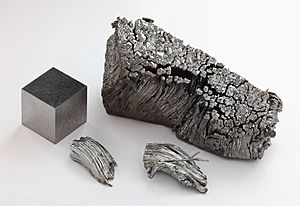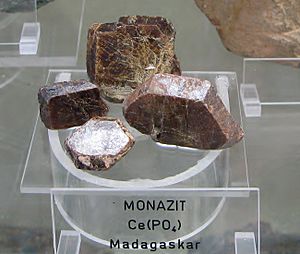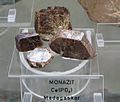Thulium facts for kids
 |
|||||||||||||||
| Thulium | |||||||||||||||
|---|---|---|---|---|---|---|---|---|---|---|---|---|---|---|---|
| Pronunciation | /ˈθjuːliəm/ |
||||||||||||||
| Appearance | silvery gray | ||||||||||||||
| Standard atomic weight Ar, std(Tm) | 168.934218(6) | ||||||||||||||
| Thulium in the periodic table | |||||||||||||||
|
|||||||||||||||
| Atomic number (Z) | 69 | ||||||||||||||
| Group | n/a | ||||||||||||||
| Period | period 6 | ||||||||||||||
| Block | f | ||||||||||||||
| Electron configuration | [Xe] 4f13 6s2 | ||||||||||||||
| Electrons per shell | 2, 8, 18, 31, 8, 2 | ||||||||||||||
| Physical properties | |||||||||||||||
| Phase at STP | solid | ||||||||||||||
| Melting point | 1818 K (1545 °C, 2813 °F) | ||||||||||||||
| Boiling point | 2223 K (1950 °C, 3542 °F) | ||||||||||||||
| Density when liquid (at m.p.) | 8.56 g/cm3 | ||||||||||||||
| Heat of fusion | 16.84 kJ/mol | ||||||||||||||
| Heat of vaporization | 191 kJ/mol | ||||||||||||||
| Molar heat capacity | 27.03 J/(mol·K) | ||||||||||||||
Vapor pressure
|
|||||||||||||||
| Atomic properties | |||||||||||||||
| Oxidation states | +2, +3 (a basic oxide) | ||||||||||||||
| Electronegativity | Pauling scale: 1.25 | ||||||||||||||
| Ionization energies |
|
||||||||||||||
| Atomic radius | empirical: 176 pm | ||||||||||||||
| Covalent radius | 190±10 pm | ||||||||||||||
| Spectral lines of thulium | |||||||||||||||
| Other properties | |||||||||||||||
| Natural occurrence | primordial | ||||||||||||||
| Crystal structure | hexagonal close-packed (hcp) | ||||||||||||||
| Thermal expansion | poly: 13.3 µm/(m⋅K) (at r.t.) | ||||||||||||||
| Thermal conductivity | 16.9 W/(m⋅K) | ||||||||||||||
| Electrical resistivity | poly: 676 nΩ⋅m (at r.t.) | ||||||||||||||
| Magnetic ordering | paramagnetic (at 300 K) | ||||||||||||||
| Molar magnetic susceptibility | +25500×10−6 cm3/mol (291 K) | ||||||||||||||
| Young's modulus | 74.0 GPa | ||||||||||||||
| Shear modulus | 30.5 GPa | ||||||||||||||
| Bulk modulus | 44.5 GPa | ||||||||||||||
| Poisson ratio | 0.213 | ||||||||||||||
| Vickers hardness | 470–650 MPa | ||||||||||||||
| Brinell hardness | 470–900 MPa | ||||||||||||||
| CAS Number | 7440-30-4 | ||||||||||||||
| History | |||||||||||||||
| Naming | after Thule, a mythical region in Scandinavia | ||||||||||||||
| Discovery | Per Teodor Cleve (1879) | ||||||||||||||
| First isolation | Wilhelm Klemm and Heinrich Bommer (1936) | ||||||||||||||
|
|||||||||||||||
Imagine a shiny, silvery-gray metal that's quite rare! That's Thulium (pronounced THOO-lee-um). It's a special kind of chemical element with the symbol Tm and atomic number 69. Thulium belongs to a group of metals called lanthanides. It's one of the rarest lanthanides found in the Earth's crust. This metal is soft enough to cut with a knife and can be shaped easily. It also gets a bit dull when exposed to air over time. Even though it's expensive and hard to find, thulium is important for making powerful solid-state lasers. It's not usually found in living things and isn't very harmful. Special types of thulium, called radioactive isotopes, are used in some portable X-ray machines.
Contents
What Are Thulium's Properties?
Physical Characteristics of Thulium
Pure thulium metal looks bright and silvery when it's fresh. But if you leave it out in the air, it slowly loses its shine. It's quite soft, like a bar of soap, and you can even cut it with a knife! This means it's also malleable (can be hammered into shapes) and ductile (can be pulled into wires). Thulium has interesting magnetic properties that change with temperature. It can exist in two main forms, called allotropes, which have different crystal structures.
How Thulium Reacts with Other Elements
Thulium reacts with other substances. It slowly tarnishes in the air, but if you heat it to 150°C, it will burn and form a compound called thulium(III) oxide. It also reacts with water, slowly with cold water and faster with hot water, to create thulium hydroxide. Thulium can combine with elements like fluorine, chlorine, bromine, and iodine (these are called halogens). These reactions are slow at room temperature but become very active when heated. When thulium dissolves in acids, it forms pale green ions (charged atoms) that glow bright blue under certain conditions! Thulium can also form many other compounds with different elements. Its most common form in compounds is called the +3 state.
Thulium Isotopes: Different Versions of the Atom
All atoms of an element have the same number of protons, but they can have different numbers of neutrons. These different versions are called isotopes. Natural thulium has one main stable isotope, called thulium-169. Scientists have also found many other isotopes of thulium, ranging from thulium-144 to thulium-183. Some of these isotopes are radioactive, meaning they slowly change into other elements over time. For example, thulium-171 takes about 1.92 years to decay by half, and thulium-170 takes about 128.6 days. Most other radioactive thulium isotopes decay much faster, in less than 10 minutes.
How Was Thulium Discovered?
The story of thulium began in 1879 with a Swedish chemist named Per Teodor Cleve. He was carefully examining other rare earth elements. Cleve found two new substances while working with a mineral called erbia. One was brown, and he named it holmia (the oxide of holmium). The other was green, and he named it thulia. This "thulia" was the oxide of the new element, thulium!
Cleve named thulium after "Thule," an ancient name for a northern land, possibly Scandinavia or Iceland. At first, its symbol was 'Tu', but it was later changed to 'Tm'.
Getting pure thulium was a big challenge. In 1911, a British chemist named Charles James finally managed to get a nearly pure sample. He worked at New Hampshire College in the USA. He used a special method called "bromate fractional crystallization." It was a lot of work – he had to repeat the purification process 15,000 times!
By the late 1950s, it became easier to produce very pure thulium oxide. This was thanks to new technologies like ion-exchange separation. Because it was so rare and hard to get, thulium was (and still is) quite expensive.
Where Can We Find Thulium?
You won't find pure thulium metal just lying around in nature. Instead, it's always mixed in tiny amounts with other rare earth elements inside minerals. It's often found alongside elements like yttrium and gadolinium. Some minerals where thulium can be found include monazite, xenotime, and euxenite.
Thulium is quite rare in the Earth's crust, making up only about 0.5 milligrams per kilogram. That's like finding half a grain of sand in a kilogram of dirt! It's also present in very tiny amounts in soil and seawater. The largest amounts of thulium ore are found in China. Other countries with significant reserves include Australia, Brazil, India, and the United States. In 2001, the world had about 100,000 tonnes of thulium reserves. It's the second rarest lanthanide on Earth, only less common than radioactive promethium.
How Do We Get Thulium?
Scientists get thulium mainly from monazite ores, which are often found in river sands. These ores contain only a tiny amount of thulium, about 0.007%. Special methods like ion exchange are used to separate the thulium from other elements. Newer techniques have made this process easier and less costly. Today, a major source of thulium is from special clays found in southern China.
Once the thulium oxide is separated, the pure metal can be created. This is done by using other metals like lanthanum or calcium to pull the oxygen away from the thulium oxide. In 2001, about 50 tonnes of thulium oxide were produced worldwide. Because it's so rare and difficult to extract, thulium metal is very expensive. For example, in 2005, a gram of 99%-pure thulium metal powder cost about US$70.
What Is Thulium Used For?
Lasers Made with Thulium
Thulium is a key ingredient in some powerful lasers. These lasers are often used in military equipment, medicine, and for studying weather. For example, lasers that use thulium along with holmium and chromium are very efficient. Thulium-based lasers are great for precise surgery because they can remove tissue with very little damage to the surrounding area.
Thulium as an X-ray Source
Even though it's expensive, thulium is used in portable X-ray devices. Scientists create a special type of thulium, called thulium-170, by bombarding natural thulium with tiny particles called neutrons in a nuclear reactor. This radioactive thulium-170 gives off X-rays. These small X-ray sources are useful for about a year. They help doctors and dentists see inside the body and can also check for hidden problems in machines. They don't need a lot of heavy shielding, just a small lead cup. Thulium-170 is also becoming popular for certain cancer treatments.
Other Uses for Thulium
Thulium has other interesting uses. It's been explored for use in high-temperature superconductors, which are materials that can conduct electricity with no resistance at certain temperatures. It might also be used in ferrites, which are magnetic materials found in microwave equipment. Thulium can also be used in special lights because it gives off a unique green light. Because thulium glows blue under ultraviolet light, it's even added to euro banknotes to help prevent counterfeiting.
Is Thulium Safe?
Thulium compounds that dissolve in water are only slightly harmful. However, thulium compounds that don't dissolve are completely safe. If thulium is injected into the body, it can affect the liver and spleen. But overall, thulium has a low level of toxicity.
In humans, the largest amounts of thulium are found in the liver, kidneys, and bones. People usually take in very tiny amounts of thulium each year, often just a few micrograms. Plants don't absorb much thulium from the soil. Thulium metal dust can be a fire or explosion hazard.
| Periodic table | |||||||||||||||||||||||||||||||||||||||||
|---|---|---|---|---|---|---|---|---|---|---|---|---|---|---|---|---|---|---|---|---|---|---|---|---|---|---|---|---|---|---|---|---|---|---|---|---|---|---|---|---|---|
| H | He | ||||||||||||||||||||||||||||||||||||||||
| Li | Be | B | C | N | O | F | Ne | ||||||||||||||||||||||||||||||||||
| Na | Mg | Al | Si | P | S | Cl | Ar | ||||||||||||||||||||||||||||||||||
| K | Ca | Sc | Ti | V | Cr | Mn | Fe | Co | Ni | Cu | Zn | Ga | Ge | As | Se | Br | Kr | ||||||||||||||||||||||||
| Rb | Sr | Y | Zr | Nb | Mo | Tc | Ru | Rh | Pd | Ag | Cd | In | Sn | Sb | Te | I | Xe | ||||||||||||||||||||||||
| Cs | Ba | La | Ce | Pr | Nd | Pm | Sm | Eu | Gd | Tb | Dy | Ho | Er | Tm | Yb | Lu | Hf | Ta | W | Re | Os | Ir | Pt | Au | Hg | Tl | Pb | Bi | Po | At | Rn | ||||||||||
| Fr | Ra | Ac | Th | Pa | U | Np | Pu | Am | Cm | Bk | Cf | Es | Fm | Md | No | Lr | Rf | Db | Sg | Bh | Hs | Mt | Ds | Rg | Cn | Uut | Fl | Uup | Lv | Uus | Uuo | ||||||||||
|
|||||||||||||||||||||||||||||||||||||||||
Images for kids
See also
 In Spanish: Tulio para niños
In Spanish: Tulio para niños






